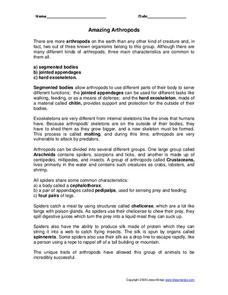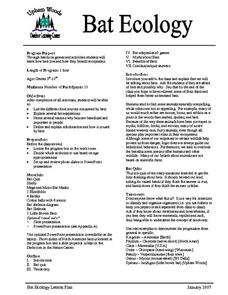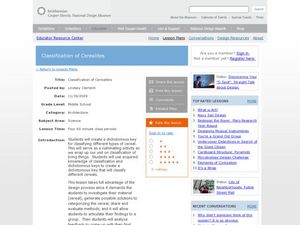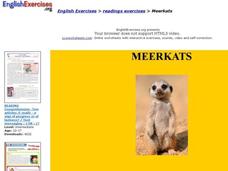McGraw Hill
Chapter 20: Arthropods and Echinoderms
Learn all about echinoderms and arthropods through the attached reading, complete with stunning photographs and review questions; keep track of the key concepts using the handout. For kids with a lower reading level, consider projecting...
Curated OER
Habitat Happenings
Students examine the characteristics of the Prairie Creek Habitat in Illinois. In groups, they travel between various stations writing haikus and reading brochures. They identify what occurs in each habitat and identify the animals...
Curated OER
Growing Garden Companions.
Students understand that some plants grow better with other plants. In this companion planting lesson, students observe the "three sisters" growing system used by the Native Americans. Students understand that small gardens grow better...
Curated OER
Links in the Chain of Life
Using the prairie dog community as an example, middle school ecologists examine the food web. Pairs of learners take one species in the community and research its role in the ecosystem. They share their findings with the rest of the...
Curated OER
Practice Multiplying by 6, 7, and 8
In this multiplication practice worksheet, students sharpen their problem solving skills as they solve 6 story problems that require them to multiply by 6, 7, and 8.
Curated OER
Charlotte's Web
Fourth graders focus on fluency by reading the book Charlotte's Web. In this reading strategies lesson, 4th graders partner read, do guided reading, and independent reading to increase fluency. Students use Venn Diagrams, discuss...
Curated OER
Amazing Arthropods
In this amazing arthropods worksheet, students read for information and assess comprehension. In this true and false, fill in the bank, multiple choice and short answer worksheet, students write answers to ten questions.
Curated OER
Bat Ecology
Students, through hands on games and activities, discover how bats live and how bats benefit ecosystems. They play a game designed to show them how echolocation works and another to show how mother bats locate their young through their...
Curated OER
Questions And Statements
In this questions and statements worksheet, students review the differences between the two and put the correct end punctuation on ten sentences. Students, in addition, unscramble three groups of words to form a question and a statement.
Curated OER
The Listening Walk
Students play instruments that reflect sounds in the story: hoots, toots, creaking, shrieks, clacking, crunching, whooshing, etc. They make vocal sounds from the story: whispered, sniffled, sigh, giggled, croaked, laughed. The...
Curated OER
Learning About Decay Demonstrations
Students explore decay in ecosystems by investigating a rotting log and/orcreating a decomposition chamber. They make predictions and answer questions about the changes involved.
Curated OER
Activity Plan 5-6: Book-Character Homes
Students use their creativity to build character homes. For this early childhood lesson plan, students develop creative-thinking, social, language, math, and motor skills as they work together to create buildings for characters from...
Curated OER
Addition with Regrouping
In this regrouping in addition worksheet, students use the table for the 'Threatened and Endangered Animals' and their numbers to solve the addition problems that utilize regrouping.
Curated OER
Breaking News English: Bees
In this bees worksheet, students read the article, answer true and false questions, complete synonym matching, complete phrase matching, complete a gap fill, answer short answer questions, answer discussion questions, write, and more...
Scholastic
Mixed Bags: Fiction and Nonfiction
Using a bag with one fiction and non-fiction book of similar topics, partners work together to find the differences and similarities of each story. They record their obervances in a T-chart.
Curated OER
Studying Birds in the Field
This is a well-designed science activity which helps learners learn the behavior of different species of birds. Working with partners and in small team, students learn to scientifically observe birds.
Curated OER
Animals, Soil, Trees
Fourth graders describe the various kinds of soils and how plants and animals are affected by them. They describe the baic needs of plants, scoring at least a 3 or 4 on a 4-point rubic. Students are able to predict and/or infer what...
Curated OER
Hatched From An Egg
Students discover how animals are born/hatched. In this life science lesson, students listen to a book entitled Chickens Aren't The Only Ones, and discuss animals that are hatched or born. Students receive a picture of an animal,...
Curated OER
Fossil Formation Fun
Students compare the three types of fossils: preserved organisms, mineral replacement fossils, and impression fossils. They create a model of amber,
sponge fossil, and make traces of fossil.
Curated OER
Science Charades
Students dramatize the wonderful world of nature, without making a sound. For this early childhood creative thinking lesson, students dramatize different aspects of nature to develop creative thinking, reading, memory, and motor skills.
Curated OER
The Froggy Page
Students investigate the cycle of life by observing tadpoles. In this biology lesson, students utilize the Internet to read stories, observe pictures, and listen to sounds of frogs. Students create a poster board collage...
Curated OER
Classification of Cerealites
Students create a dichotomous key. In this categorizing activity, students create a dichotomous key for different types of cereal. Students classify the cereal into groups such as flakes and cereal with holes. Students discuss their...
Curated OER
MeerKats - Reading Exercises
In this meerkats reading comprehension online worksheet, students read a story about meerkats. They insert the proper words into the selection using words from the bank at the bottom of the page.
Curated OER
Meeting an Earthworm
Students inspect the anatomy of earthworms. In this earthworm lesson plan, students participate in a hands-on experiment as they analyze the structure of earthworms. Students demonstrate mastery through differentiated products. Lesson...























